Get to know some reclusive neighbors in your own backyard. Page 4
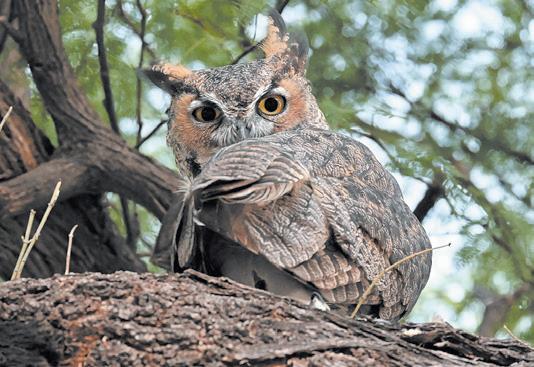
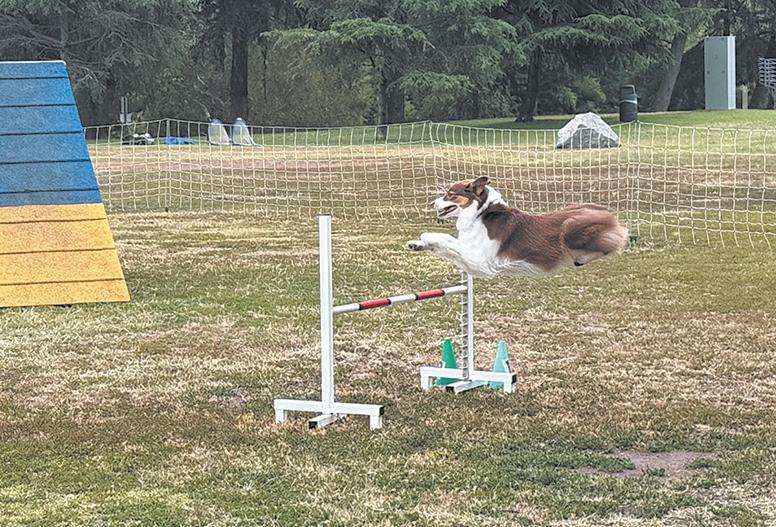
Homeboy Industries adds dog grooming to its many social enterprises. Page 14 RAPTOR STUDY
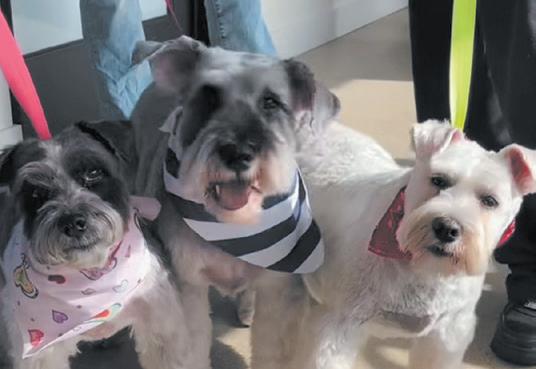


Get to know some reclusive neighbors in your own backyard. Page 4


Homeboy Industries adds dog grooming to its many social enterprises. Page 14 RAPTOR STUDY


Three and a half years after the approval of plans to restore and add an additional story to the property at 304 S. Plymouth Blvd., it seems at long last that work has finally begun. I had covered the long and troubled saga of 304 S. Plymouth Blvd. in my December 2021 column titled, “Will a historic ranch house on Plymouth Blvd. finally be reborn?” The article covered the approval by the Windsor Square Historic Preservation Overlay Zone (HPOZ) Board
The home was designed as a low-slung ranch-style house in 1949 by architect Y. W. Nibecker for Mr. Harry Carian Sr., an Armenian immigrant and prominent grape grower of the Coachella Valley.
of a plan to restore and modernize the 1949 ranch-style house at the corner of Plymouth and Third Street. What followed were three and a half more years of neglect, vandalism and transient occupation, much to the irritation of the neighbors who had longed for a happy conclusion to issues at the nuisance property. So it was with great surprise last month that I came to a halt in front of 304 S. Plym-
by Brian Curran
outh and saw men on the roof of the house tearing off shingles and plywood, removing windows and filling large dumpsters in the driveway. Having been in the preservation game long enough, I had been through my fair share of “lightning” demos—when historic buildings are torn down illegally or significantly damaged enough that they lose their historicity. While I had long feared that 304 S. Plymouth would one day succumb to its twin afflictions of vacancy and neglect, most likely by catching fire, I did not expect it to be demolished in broad daylight.
The home was designed as a low-slung ranch-style house in 1949 by architect Y. W. Nibecker for Mr. Harry Carian Sr., an Armenian immigrant and prominent grape grower of the Coachella Valley. Carian had purchased one of the many available corner lots in Windsor Square and Hancock Park that remained empty until after WWII. The house changed hands many times over the years, yet remained occupied until the early

2000s, when it was acquired by Kim Kwang Tae. Tae allowed the property to decline and deteriorate through neglect over two decades.
After numerous complaints by the neighbors and threats of fines by the city authorities, the property was sold in 2020 to attorney and financier Ben Donel. He commissioned the architects Jane Keener and Matt Steele of Architecture JHK to create a design to improve and expand the house in a way that would satisfy the HPOZ Board. The board approved their design in November 2021. Soon after, the property was put up for sale.
It remained on the market for over three years, and the cycle of decline sadly continued.
When I saw the crew of men tearing the house apart, I quickly searched to find a demolition permit, and finding none, fired a note to Damian Gatto, the city planner responsible for Windsor Square, to inform him of a possible illegal demolition.
After further searching, I found a new permit issued in April of this year for the additions and remodel approved in 2021. Gatto forwarded me the approved project’s demolition plan for the house, which, much to my relief,
appeared to correspond to the work I saw being carried out. The Plymouth and Third Street facades were preserved, while the interior and rear structure was knocked down to the studs in preparation for new work to begin. I intend to keep an eye on the continuing works at 304 (Full disclosure: I live down the street on Plymouth Boulevard) to either prevent the complete demolition of the house or, more preferably, to follow with a great sense of relief the restoration and rebirth of a long-neglected corner of Windsor Square. I will keep you posted!
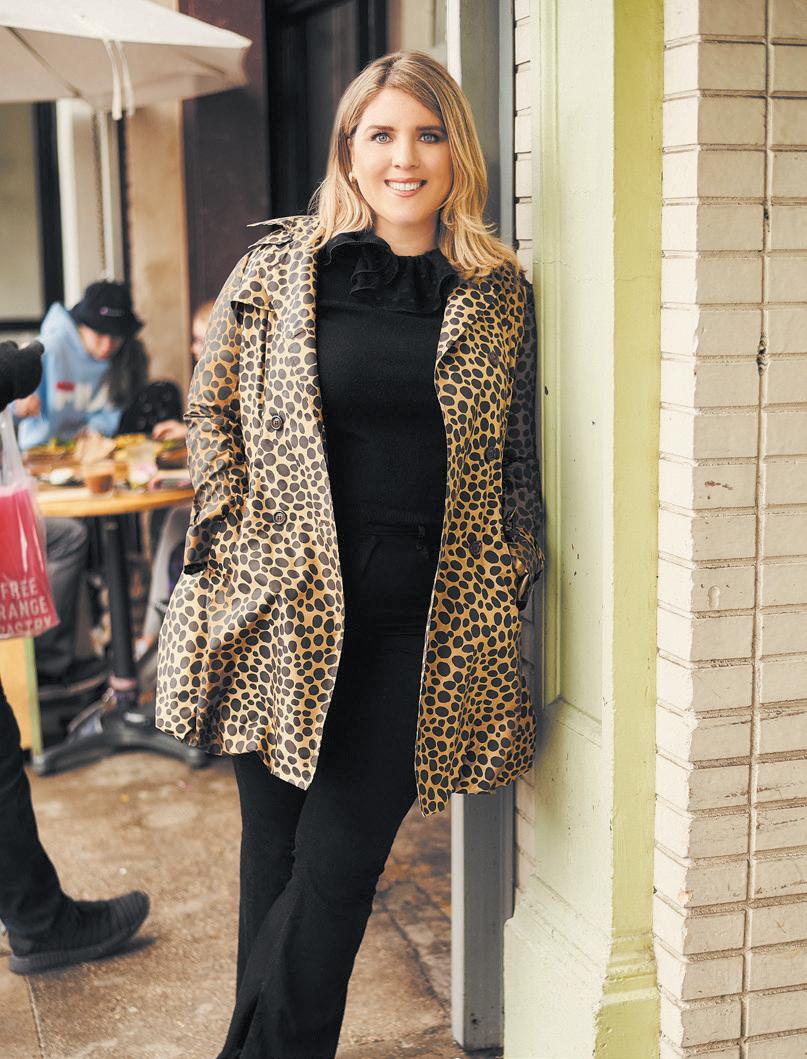
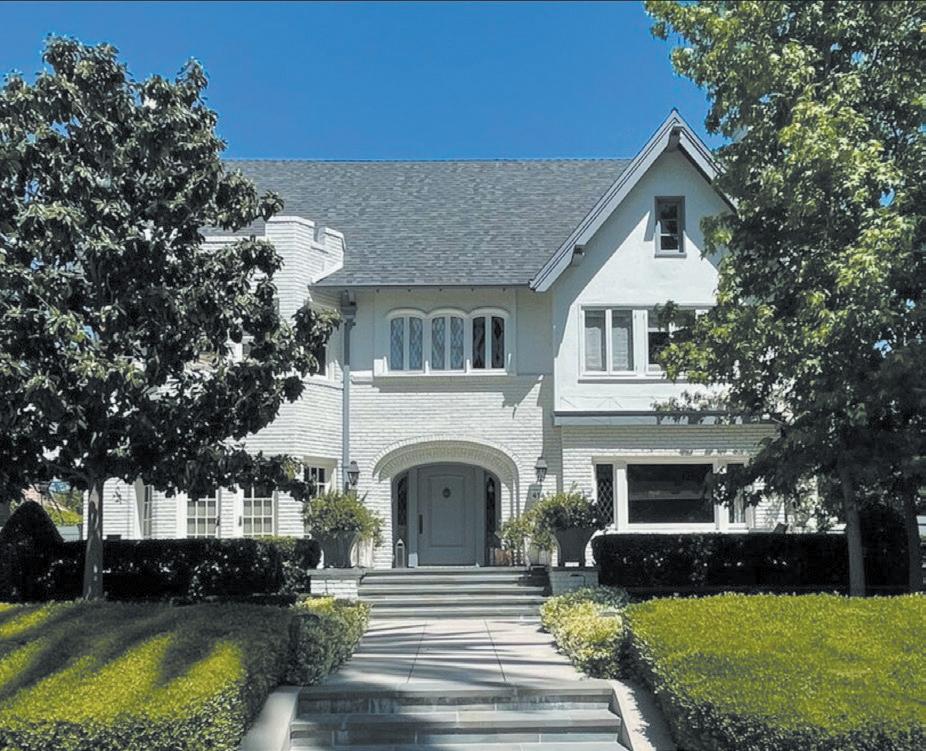



By Jim Kalin
The best of our local 12-year-old Wilshire Warriors headed to Dreams Park Cooperstown in New York on June 18 to participate in a baseball summer camp where close to 100 teams from all over the U.S. attend per week. Wilshire Warriors is a recreational community baseball club based at Pan Pacific Park.
Dreams Park was constructed in 1996. There are 22 grass playing fields and 104 barracks on the 165-acre Baseball Village. The fields have lights, so the boys play night games, too. Cooperstown is a family destination, with parents and siblings encouraged to attend games when not on Otsego Lake or touring the Baseball Hall of Fame. The experience for the
CROSSWORD ANSWER

players mirrors big league ball as much as possible.
Prior to Cooperstown, these Wilshire Warriors 12U Blue Team players, some who have been playing together since they were 7, won three local tournaments in a row, including the prestigious Cheviot Hills Memorial Day Tournament, an event played over a four-day span. It was quite a dramatic run.
“I couldn’t be more proud of this team. They’ve put in countless hours of hard work together over the past sever-
al seasons under the guidance of our amazing coach, Kris Davis. And it’s been incredibly rewarding to see all their hard work yield such great results on the field,” Team Manager Adam Cole-Kelly told us.
The Warriors won their semifinal game on Sunday evening 3-2 in extra innings to progress to a finals rematch with rival Palisades, who had defeated them the previous four years. The next day, on Memorial Day, the Warriors finally broke through and beat Palisades 3-2 for the championship.
By H. Hutcheson
The Marlborough Equestrian Team had a great year as they won the Overall Team High Point Interscholastic Equestrian League Reserve Champions.
Crystal Li, rising 10th grader and local resident, is the Freshman Jumper Reserve Champion (2nd in League in a group of 25 riders) with her horse Lewis.
Li, having just completed her freshman year at Marlborough, said, “I really enjoy how an individual sport like equestrian can become a team effort. Even though we compete individually, having the support and encouragement of my teammates makes a big difference.”
Becoming an expert in any sport is a big time commitment. Li said, “It is not just about the hours spent training. Building trust and forming a bond with each horse takes time and patience. Every horse is unique. I currently own two horses, Ollie and Lewis. I connected instantly with Ollie on my second day of riding. Lewis, who jumps much higher, took longer for me to bond with. That experience has taught me a lot about patience, understanding and perseverance.”
(Please turn to Page 4)

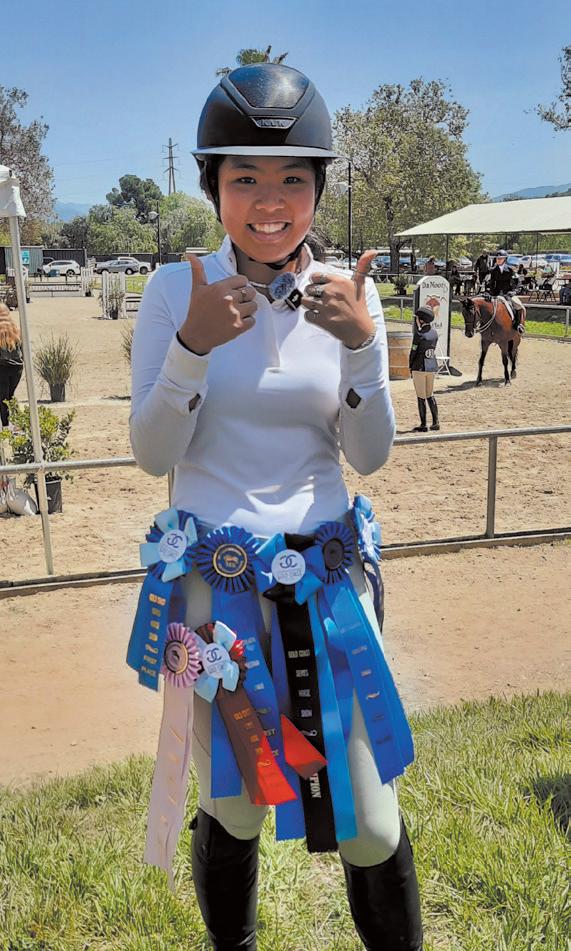

By H. Hutcheson
Having your very own pet and the constant responsibilities they require is not for everyone. But how about a relationship with an animal that you have no obligation to?
The L.A. Raptor Study, sponsored by Friends of Griffith Park and the Resource Conservation District of the Santa Monica Mountains, seeks volunteers to take on a raptor—behind a pair of binoculars.
Participants watch nests of Great Horned Owls, Redtailed and Cooper’s hawks, falcons and other majestic, powerful top predators.
Launched in 2017, the research group assigns novices to learn by observing populations in parks, schools and even in your own backyard. The program starts with a general information Zoom every January. In-the-field meetings begin in March and April. May holds the promise of egg incubation, chicks and fledglings. In August, volunteers celebrate with a party, including data analysis and presentations.
Nurit Katz, a co-director of the study, who is currently working toward a Ph.D. in ecology and evolutionary biology at UCLA, said, “It’s

really a community science project. We find many of the nests we watch from neighbors offering information.”
So many predators are threatened by the top predator on this beautiful planet—us. Katz said studying the birds by collecting data on them and analyzing it “teaches us how they are adapting to city environments. Key predators help keep populations in balance and contribute to biodiversity. They help maintain healthy populations. When you remove a predator, there can be a collapsing of an ecosystem.”
Katz is also researching
the cultural relationship of Indigenous populations to birds of prey.
Dave Brown of North Irving Boulevard has been working with the program for a few years, observing a Cooper’s hawk’s nest in a cedar tree within his parkway. “The hawks mate for life and will often reuse a nest for years. One year they hatched two chicks. The next year there were three eggs, but just two hatched,” Brown said. He also pointed out what we all know about the Larchmont area in particular: “We are so lucky to live in the middle of a huge city and have nature

right nearby.”
Unfortunately, the same winds that contributed to the January wildfires in Los Angeles also destroyed the hawk’s nest. Brown said he realized by April there would
(Continued from Page 3)
Li is sure horses will be in her future one way or another. She said, “I have created an app to help equestrians with barn management. Even if I am not interacting with horses every day, I will defi-
be no chicks. He mentioned he has his own baby due soon (“By stork?” I asked), so dad might be busy learning about a new sort of baby. Not ready for any relationship to animals yet? That’s perfectly acceptable. But we, as the very top predators on earth, can all be good stewards to raptors. Katz said, “People can plant native plants that attract native bugs. Don’t ever use rat poison that will inevitably kill a bird or other animal. Keep leaves under your shrubs, and please resist trimming trees during nesting season, which is mostly during spring and summer months (except the Great Horned Owls, who sit on their nests in January).”
To become a volunteer or learn more, visit friendsofgriffithpark.org. To learn safe practices in the maintenance of your land, visit treecareforbirds.com.
nitely keep improving my app so that life can be easier for riders and barn managers. The experiences and lessons I have gained through riding will continue to guide me in whatever I do next.”
Li’s app is called Horsitask and can be found on Apple’s App Store and Google Play.


By Suzan Filipek
About a year after I adopted Bella, a shiny black Lab, someone at a dog park that we frequented suggested I sign my dog up for an agility class.
“It’s fun,” the dog park visitor said.
I knew nothing about the sport, which I’ve since learned is physically and mentally stimulating both for dogs of all sizes and breeds, and their handlers—which would be me.
I was all in to keep my energetic pup busy and happy.
Beginning-to-advanced agility classes are sponsored by the nonprofit West Los Angeles Obedience Dog Training Club. They are held outdoors near giant jacaranda trees at Cheviot Hills Recreation Center. There was a waiting list, but the club also offers several types of classes, so we took a few obedience classes over the months while we waited.
Eventually we got in to Basic Agility, and over many years we moved up the levels till we landed in Advanced! Bella was a sweetheart—her tail wagged with everyone she met. While she trotted around the course’s many obstacles, the more competitive breeds raced through them. They


flew over jumps and sprinted around “weave” poles. The ensemble of equipment on the course resembles a circus site more than a sport designed to teach dog’s to focus on speed and accuracy. (The legendary Westminster Kennel Club hosts a masters in both agility and obedience at its annual televised dog show.)
Always a trooper, Bella eventually settled into a brisk walk as she got on in years. She moved slower and slower around the course during each class until she retired altogether a few years before she died at age 15.
I have also run the course with my other dogs: a miniature poodle, now 10; and an energetic Dobermann-cattle dog mix, 3, is a newcomer to the sport.

Whatever their age or breed, an agility class is a great way to spend time outdoors with your pup.
Try it. It’s fun!
For more information on agility and other courses at at the Club, including conformation, nose work and tricks, visit wlaotc.com.
Going on a trip? Why not bring your
By Nona Sue Friedman
Traveling with your pet is the norm now. Pets accompany owners to the supermarket and on hiking trails, strolls through farmers markets, road trips and even airplanes. But that wasn’t always the case. According to pet travel author Eileen Barish, “People are doing it now, but when my first book came out in ’94, it changed the whole way the hotel industry viewed pets.”
These days, more and more hotels accept pets and even cater to them.
After years of traveling with her golden retrievers, Barish has some tips to make your adventure easier. Always call in advance to find out the hotel’s pet policy. Remember to bring a leash and possibly a crate, and don’t forget some toys. If it’s a road trip, set up the back of the car to make it cozy. Bring enough food and water for the excursion. Take bathroom and exercise breaks at rest stops along the way, for you and your pet.
Barish also recommends bringing extra towels in case your tagalong friend gets wet.
The author said to check out what local restaurants accom-

author
Eileen Barish with her dog, Daisy.
modate pets, since, she says, “Many hotels won’t let you leave your pet in the room unattended.” Anyway, it’s more fun sharing more of your vacation with your furry friend if you’re bringing them along for the ride.
Eileen Barish is the author of over 10 books, including the bestseller “Doin’ California with your Pooch.” She lives in Santa Barbara with her husband and her dog, Daisy.




6 bedrooms, 4 baths, 2 half baths
Approximate sizes:
Main House 4,599 sq. ft.
Guest House 1,000 sq. ft.
24-hour in-person security guard

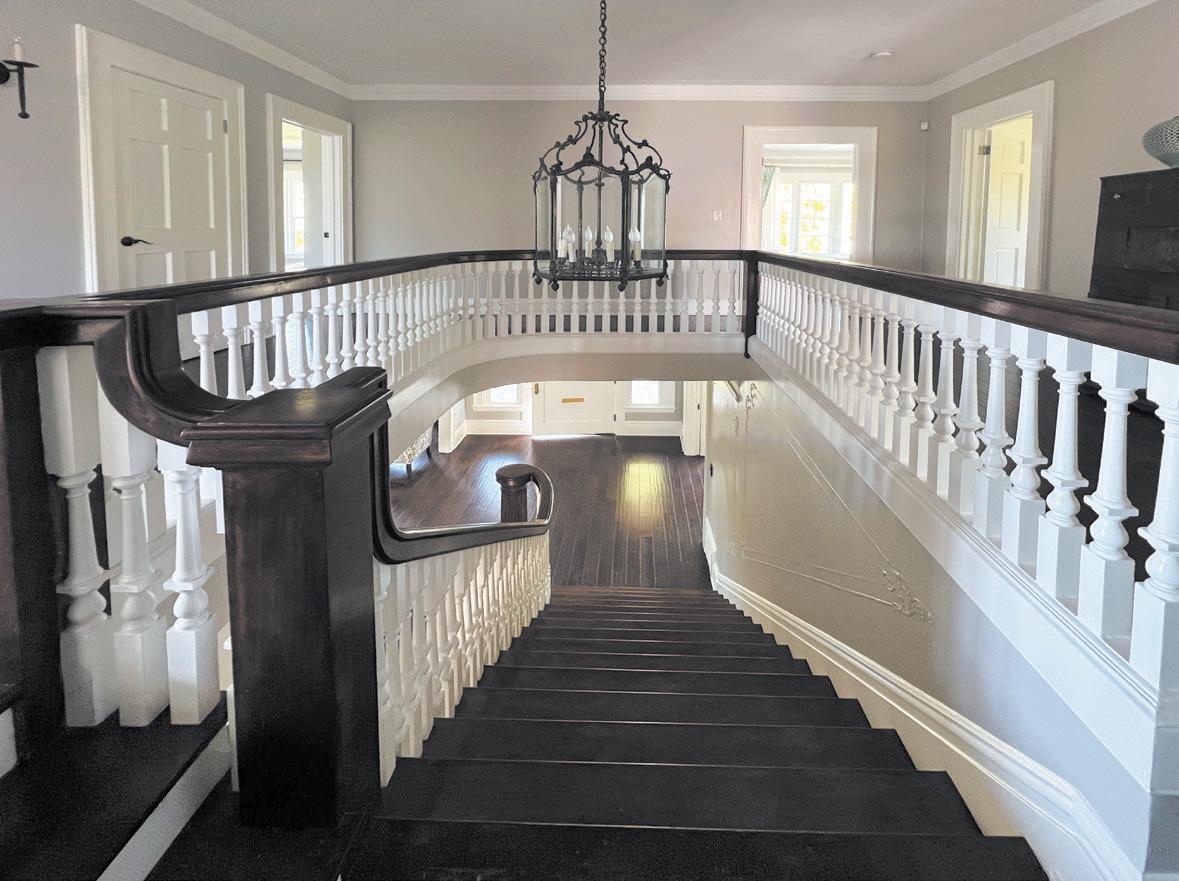
$5,450,000
appraised for $5,700,000 will pay 3% buyer’s agent commission call or text for an appointment:
310 . 956 . 6519
760 . 518 . 9655
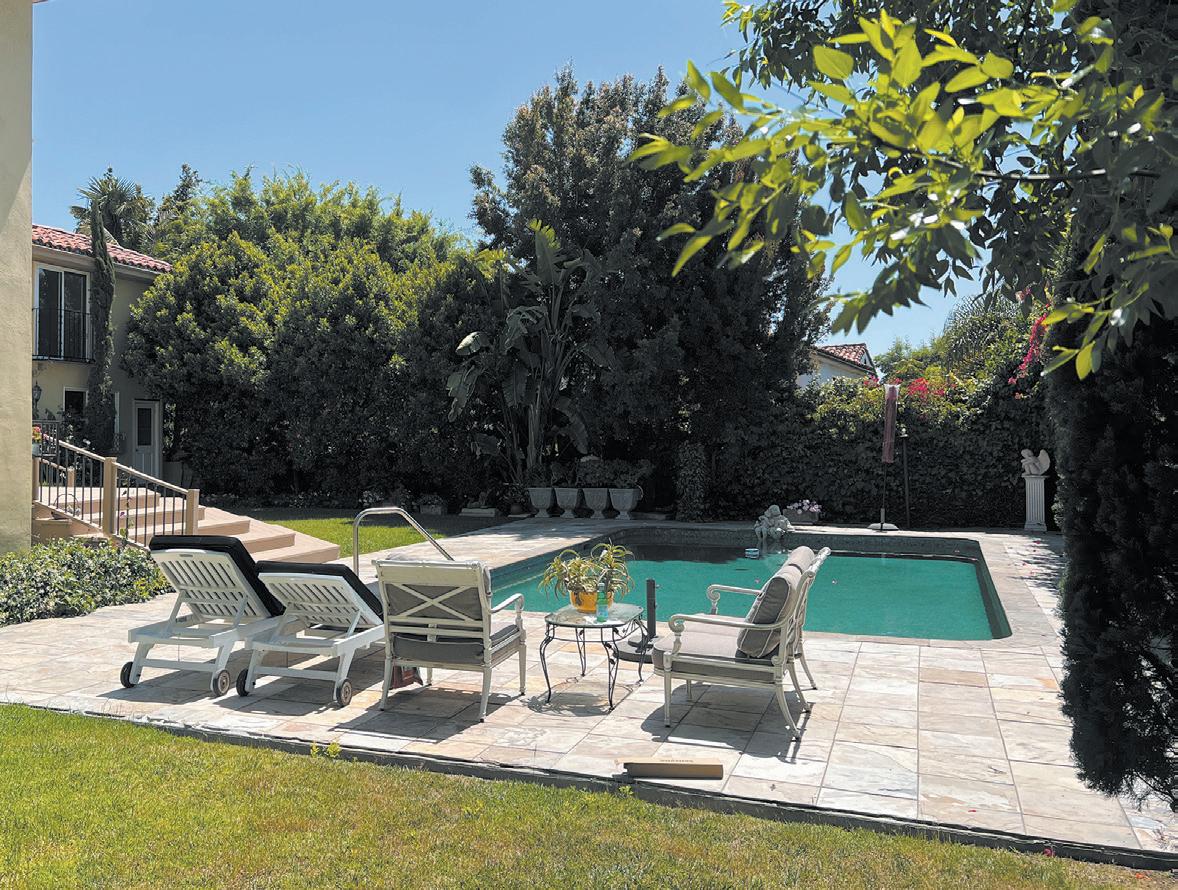
By Shoe Schuste
You know those blueberry bagels you get with a smear of cream cheese? Here’s my take on that—as a pie.
First, you must make your pie crust. Don’t worry, this will be easy—unlike every other pie crust. A gentle breeze, even.
This recipe makes two portions of dough for two single-crust pies or one double-crust. This blueberry pie will only need one of these, so you’re going to have a second pie crust to do whatever you want with. Play frisbee with the dog! You can put it in the freezer for up to three months. Defrost it in the fridge two days prior to using.
Pie crust ingredients
2 Tbsp. packed dark brown sugar
2 tsp. apple cider vinegar
1 tsp. Diamond Crystal kosher salt
2 oz. cold water
2¾ cups unbleached all-purpose flour
8 oz. cold unsalted butter, cubed
In a measuring cup, combine the brown sugar, vinegar, salt and water. Use a spoon to stir the mixture until the sugar and salt have dissolved. Leave the spoon in the cup and put the entire cup and liquid in the freezer. Don’t worry, it won’t be in there long.
In a stand mixer with a paddle attachment, add your flour and butter and spin on


low speed for a few minutes. What you’re looking for is the flour and butter to come together and take on a sand like texture. It shouldn’t take more than four minutes. If it takes two minutes, good on you! Don’t overdo it, and veer on the side of larger pebbles of butter.
While the mixer is, uh, mixing, grab your liquid from the freezer, and pour it into the sand mixture. You can use the spoon you had in there to help you if there’s any sediment stuck in the bottom of the cup. Once the dough sticks together, shut off the mixer. It’ll take you maybe 30 seconds. Emphasis on “maybe.”
If there are a few little pieces at the bottom that are still crumbly and dry, it’s all good. Don’t overdo it. Once you’re doing it, it will become obvious. Turn the dough out onto a lightly floured counter, and gently knead it a few times to bring it together into a rough rectangle. No one’s judging your geometry, just get it together, and make it about 6 by 8 inches. Again, if it’s 5 by 9, 7 by 10, it’s fine. Lightly dust a rolling pin with flour. Position the dough with the short side facing you. Now push the pin over it a few times until you’ve stretched it about 3 to 4 more inches. Again, the teach-
er’s not following behind you with a ruler regarding your measurements. Reach to the top of the dough and fold it about a third of the way down. Take the bottom and fold it over the top, like it’s a letter. You remember those pre-email things? You should have a rough square of dough. Again, it’s fine if it’s a little wonky. Cut the dough in the middle so you have two roughly equal pieces. Wrap each in plastic. Take your rolling pin and run it over each, forming the rough squares into rough circles. Whee, fun with shapes! Plop both in the fridge for an hour while you make the blueberry filling. Guess what? You just made pie crust! Preheat your oven to 375°F. Line a baking sheet with parchment paper.
(Please turn to Page 9)




(Continued from Page 8)
Filling ingredients
Makes one 9-inch pie
¾ cup granulated sugar
1 tsp. Diamond Crystal kosher salt
3 Tbsp. cornstarch
1¾ lbs. fresh blueberries
1 Tbsp. lemon juice Cream cheese crumble topping
1½ cups unbleached all-purpose flour
¼ cup packed light brown sugar
¼ cup granulated sugar
½ tsp. Diamond Crystal kosher salt
½ cup unsalted butter, melted and cooled
4 Tbsp. cold plain cream cheese For pie bottom
4 Tbsp. plain cream cheese at room temperature
In a large mixing bowl, add sugar, salt, cornstarch and half of the blueberries. Toss so all the fruit is coated. Get in there and jostle. Take the other half of the blueberries and put them in the freezer. Let the sugared fruit macerate
for a half hour. Watch some TV. Or make the crumble topping. Or do both. After 30 minutes, transfer the sugared berries and all their juices to a saucepan and cook over medium heat until the juices boil and thicken. Remove the cooked filling from the heat and transfer it to a heatproof bowl. Add the frozen blueberries and lemon juice and stir. Put aside. We’ll come back to it.
In a mixing bowl, whisk the flour, sugars and salt together in a medium mixing bowl. Add the melted butter and cream cheese. Take a fork and smush it all together, or put your fingies in there and mix it until it resembles crumble.
Assemble the pie
Lightly flour your work surface. Take one dough disc out of the fridge and remove the plastic wrap. If it’s been chilled overnight, let it sit at room temperature for 10–15 minutes until it softens slightly. Once it’s pliable, roll the dough into a 12-inch circle, dusting with flour as needed to prevent sticking. Carefully transfer the rolled
dough to a 9-inch pie plate, trimming the edges so there’s about 1 inch hanging over. Fold or roll this excess under, then crimp the edge using your thumb and forefinger. Place the crust in the freezer for 20 minutes to firm up.
Once the crust has chilled, smear the room temperature cream cheese onto the bottom of the pie crust, pour the filling over it and add all the juices that may have collected in the bottom of the bowl. Scatter the crumble over the top. You’re almost home free. Almost!
Place the entire pie in the freezer for about 15 minutes, just until it firms up a bit—it doesn’t need to be fully frozen. Transfer the pie to the prepared baking sheet and move it to the center rack of your preheated oven. Bake until the crust is a rich golden brown and the filling is bubbling—this will take about an hour, possibly a bit longer. Let the pie cool for at least an hour before serving to give the juices time to settle and thicken. Now, guess what? You have pie. Yum!














By Suzan Filipek
We received a flurry of adorable, cute and fluffy entries for this year’s 16th annual Pets of Larchmont issue. From stately poodles to charming mixes, they walk the neighborhoods, and, of course, browse for treats on Larchmont Village.
Cats prefer to stay home but add joy to those around them all the same.
“So happy to see this coming back this year!” said Julia Lin of Norton Avenue. She sent a photo of Minerva decked out in her red, white and blue finest for the Fourth of July holiday. “She loves to say hi to everyone in the neighborhood!” Lin told us.
Wiley of Windsor Village is looking especially handsome, “fresh from the groomers at Tailwashers on Larchmont!” said Katy McKinnon and Bryan Sonderman.
Roger, a Chihuahua, and cat Patricia enjoy the day together on South Windsor Boulevard, Adelaide Kuehn tells us.
Henry is a Coton de Tuléar. Legend has it that the breed originated from a group that swam across the Malagasy channel following a shipwreck. This local pup frequents Larchmont and lives in Brookside with his brother, Odin, Michael Moore and Chad Rothman told us.
“Lola is the best girl,” Meredith Quill of Irving Boulevard told us of her rescue cat. “We got her on Larchmont Boulevard about eight years ago. She doesn’t have any teeth, but she is the sweetest, most friendly cat, and everyone who meets


her falls in love with her.”
Lynn Chen took her dog Miles to the Larchmont Family Fair last October, where this photo of the pair was snapped. They live with Abe Forman-Greenwald on Bronson Avenue.
Father Justin Oh, a priest for the Archdiocese of Los Angeles and administrator at Christ the King Catholic Church on Rossmore Avenue, sent photos of his Australian shepherds Ace and Vash. “Parishioners have drawn my attention to the blurb inviting us to send in some pictures of our furry friends,” he said, adding he was glad to make this year’s issue.
Bruce, a black-and-white Berniedoodle, 4; Frankie, rescued from the Labelle Foundation, also 4; and shih tzus Andre and Milo, both 13, relax on Orange Drive and Beverly Boulevard with Heidi Richardson.
Freckles and Puff live on Norton Avenue with Sarane Van Dyke.

Steven Steinman and Doris Berger bid in a silent auction to get Bessie from the Chesterfield Square L.A. City Animal Shelter “since so many people wanted her!” Steinman said.
He continued, “She was 8 pounds when we got her, and we thought that she would stay about that size, but no. She’s 8 months old now and

about 27 pounds and will probably still be growing. She is wonderful and we feel so happy and lucky that we had her when [our previous dog] Pucci passed, since we might not have gotten another dog for a while.”
According to Adrienne Cole, Matisse, 2, “loves his walks to Larchmont with his furry friends. One of his favorite things to do along the way is relax on the grass, enjoying







(Continued from Page 10) the sunshine, especially next to the Bank of America.” The Havanese lives with the Cole


Family on Beachwood Drive.
Milo, wearing a jazzy tie with a holiday theme, lives on Wilcox Avenue near Rosewood Avenue with Anne Bodycombe.
Labradoodles Missy and Mimi always have a good time digging in the backyard, said Liz and Steve Atlee of Norton

Avenue.
Rosie and Hazel chill on Lorraine Boulevard with Tracey Durning.
Methos, a gentle, kind senior dog, joins Chance, a grumpy senior cat, and Bucky, a little rascal, on North Plymouth Boulevard


with Fernand Marasigan.
Cosmo, “the cutest dog ever!” lives with Barbara Pflaumer of Windsor Village.
Cleo has the cleanest paws in Hancock Park, said Alex and Lisa Morrison of North Las Palmas Avenue.






Hercules “is a soulful, 4 ½year-old Cavapoo who lives on North Beachwood. He can be found leaping onto the Tailwaggers ‘treats podium’ and around the neighborhood, beseechingly and hind-leggingly
(Please turn to Page 12)







(Continued from Page 11) investigating the treat zone of humans. He brings love and smiles to my elderly clients,” Elizabeth Malloy said. Maggie Houlehan and


Jerina live on North Irving Boulevard.
Oliver was rescued from L.A. Love and Leashes more than 10 years ago. A wheaten terrier and poodle mix, he loves traveling, shopping on Larchmont Boulevard and frolicking in the lush green gardens of LACMA. “Pan Pacific and LACMA are his fave spots for parks plus Larch-

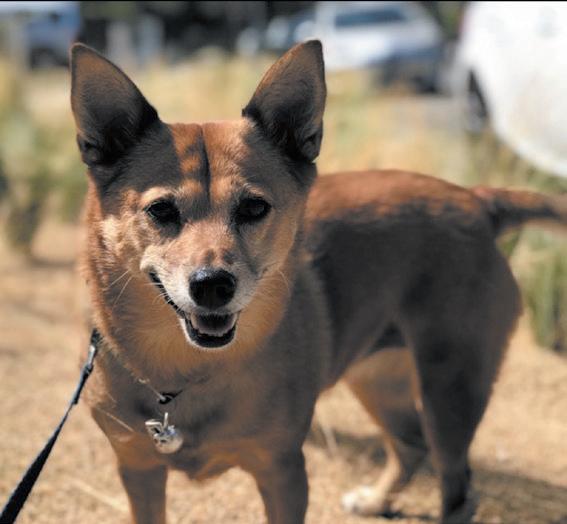
mont Boulevard for shopping and restaurants,” Colleen Broderick of Park La Brea told us.
Cody, here in his Superman outfit, lives with Ronald Alix on North Gower Street.
“Kodak likes visiting her friends on Larchmont— particularly those at Tailwaggers!” said her proud parents Crescenzo Notarile and Cary Trampf of Beachwood Drive.
“Best friends Rudy and Shady keep each other com-


pany,” while Jeff and Brian Choynake have given up possession of their recliner in their Windsor Square home.
Duffy, a Westie, is 17 ½ and lives on South Arden Boulevard. She’s “the little old lady of Larchmont Village,” Maria Kleinman said. “She’s known for stealing red velvet cupcakes and hopping-galloping on Arden. Duffy is currently recovering from pulmonary hypertension and a heart condition. Wish her well!”
Birdie, a whippet, 9, lives on Ridgewood Place with Peggy Cooper.
“Sophie is living her best life at home on South Plymouth Boulevard and on Larchmont Boulevard, where you can spot her beautiful face every day at Tailwaggers, Larchmont Beauty Center and Kreation,” Susan Goodman







told us. “Sophie makes every day marvelous. Sophie’s family has lived on Plymouth Boulevard for 54 years. Sophie and l love our community and all our local dogs and humans.”
Baby is a fan of Italian food served at La Bettola di Terroni on Larchmont, which she frequents with Christina Won of Hudson Place.
Jada, a Bernese mountain dog standard poodle mix, loves strolling in Larchmont Village, Lance Keith said.
(Please turn to Page 13)












(Continued from Page 12)
Violet often enjoys the sun in Robert Burns Park, Benjamin Bundy and his wife, Tara Armstrong, told us.
Rio, 4, is a rescue kitty from the Pasadena Humane Society, said Michele Werdin of Wilcox Avenue.
Eleanor Cilingar sent us a portrait of her pup, Baguette.

Kokomo, a Boston terrier, is looking stylish. “I can’t believe it’s already summer again and time for the Pets of Larchmont issue,” said Eugene Ahtirski of South Larchmont Boulevard.
“[We] missed the deadline last year and said I wouldn’t miss it this year. It’s her birthday in July,” Victor Hugo told us of Twyla. Oreo is still sunbathing at the grand age of 18 in Windsor Village, Matt and Lia Young tell us. Bon Jovi “loves Larchmont.

Tailwaggers is his store of choice,” said Tiffany Bollin of Hancock Park.
Wyatt Carr likes to walk Bruce, a 6-year-old Newfoundland, on Las Palmas Avenue.
Buck is a Rhodesian ridgeback and resides in Windsor Square with Rhett Hutcheson. He prefers the couch to the outdoors, but when he is outside he runs up to 30 mph chasing rabbits in Oregon.
Byrdie the pug lives with Gary Duff on Lorriane Boulevard in Windsor Square.


“We are Lucy’s humans,” said Sue and George Merlis of Lucerne Boulevard. She is a 4or 5-year-old rescue found on the streets of San Diego. “We have had her for about a year and a half. She is 60% poodle and 40% half a dozen other breeds. She would be honored to be in the July issue of the Chronicle,” said George. And we are honored to have Lucy and all of the other wonderful four-legged creatures featured in this month’s pet salute.

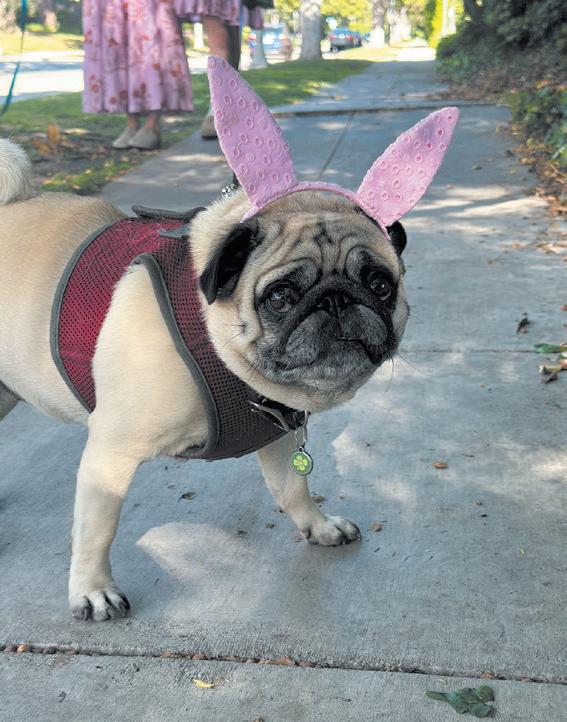










By Nancy Redford
My family is all too familiar with giving a final farewell to our pets. Until last month all of our animals died naturally at home. However, our recent experience with our 17-year-old dog, Timmy was different. Timmy’s deafness always required special consideration, and his vision had been waning. But late last year we noticed his back legs would slide out from beneath him, and he often yelped when touched. He would begin panting for no apparent reason. He could no longer manage stairs,
and he started whimpering at bedtime. It was becoming clear to us that his quality of life was in decline.
I wish we had known to arrange a formal Quality of Life Consultation, a support service offered by veterinarians as well as animal hospice specialists. These sessions can provide the family with critical guidance. Medical treatment and pain management options are discussed. It provides a professional perspective about the pet’s physical and emotional needs as well as compassionate support for the family. It
would have helped us understand and prepare for the next stages of Timmy’s endof-life journey.
Hospice Care Mode. We watched Timmy’s condition deteriorate and sensed his growing anxiety. We did everything we could to make him comfortable and instinctually went into hospice care mode. We modified our home, creating safe places for him. There were many trips to the vet, medication changes and the inevitable puddles and poops around the house. The stress began to take a toll, but we were determined to maintain a peaceful setting.
Anticipatory Grief. We began to experience a stage we now know as “anticipatory grief:” a deep mourning for the ailing pet. This natural response triggers a range of emotions including anxiety, fear and even anger.

Thoughts such as, “Why didn’t I notice the symptoms sooner?” and “What more can I do?” run through your mind. It is an overwhelming sense of helplessness.
Humane Euthanasia. The time came to accept that we needed to consider humane euthanasia. You can arrange
for this procedure to be done at a veterinarian clinic or in the comfort of your home. A licensed veterinarian intravenously administers drugs for muscle relaxation and a painless termination of nerve transmission. Once it is determined the pet is completely asleep, the pet is given a final injection and quickly transitions from life to death. After the pet has passed, the family is given private time to grieve. The pet’s body is then wrapped and transported to a cremation service.
There are bereavement support groups and specialized counseling to help with the anguish that is common with the death of a pet. One can try birchbarkfoundation.org, which offers online sessions, or lapoflove.com, which has a free weekly virtual pet loss support group. I know I will keep that in mind.
Father Gregory Boyle was on-site for the opening of the dog-grooming salon Puppy Fades, the newest program of Homeboy Industries, a gang intervention and rehab program founded by Boyle in 1988.
Formerly incarcerated members of Homeboy complete an 18-month training program before working at the new Pasadena-based salon or at any of Homeboy several social services enterprises.
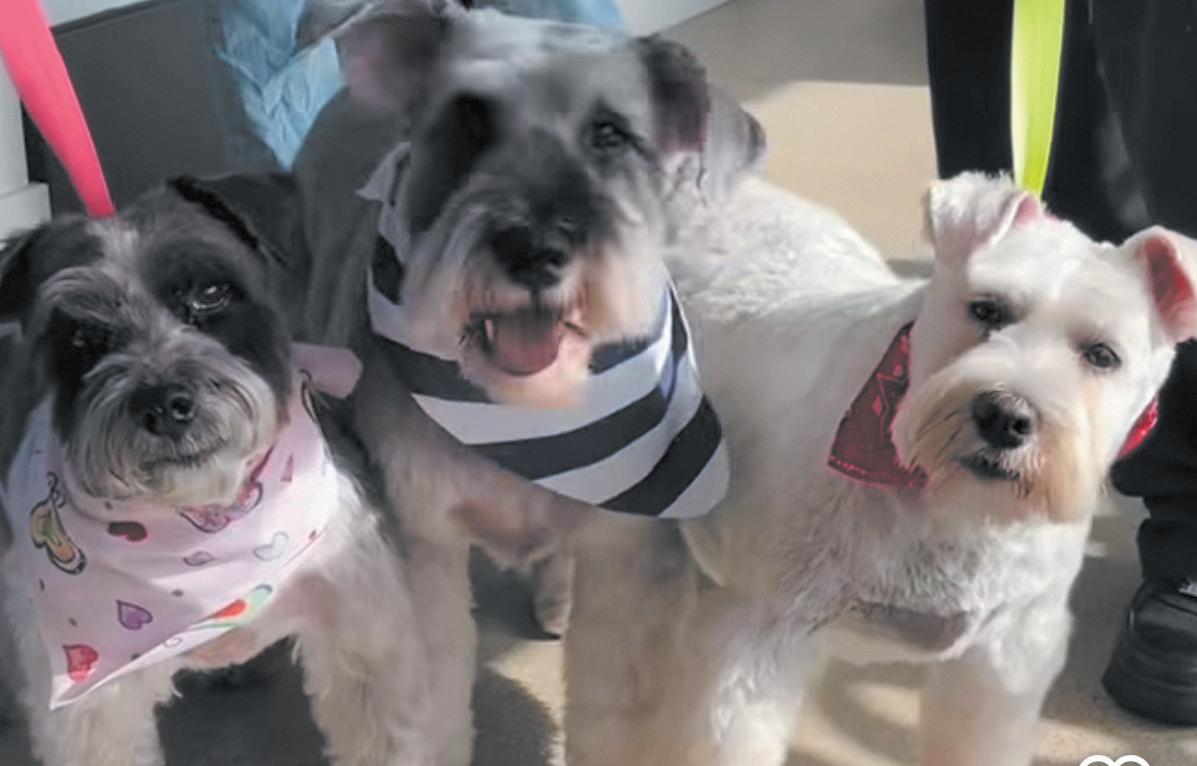
ACROSS
3. Queen’s dog, Jane
6. “Polly wanna cracker?”
7. Star of “Happy Feet”
9. Tarzan’s girlfriend
10. “Not a creature was stirring....”
13. Spanish Riding School horse
14. Largest mammal on Earth
16. Tom and _____
17. L.A. raptor that nests in January
18. Mascot of Slytherin House
DOWN
1. Killed Robert Baratheon
2. Biting Scottish flies
3. Largest living saltwater reptile
4. Calming space for dogs
5. Ancestral trait on horse legs
8. TikTok cat with the most followers
11. Armored mammal
12. “Old Possum’s Book of Practical Cats” author
14. Star of “Call of the Wild”
15. Interacts with ancestors’ bones
ANSWERS: Please turn to page 3. Answers will also be on our online edition in early July.
The groomers also complete a program accredited by the World Grooming Certification Alliance.
Puppy Fades is at 446 S. Fair Oaks Ave. in Pasadena. Homeboy, based in East L.A., has evolved into the largest gang intervention and rehab program in the world.
Boyle, a Jesuit Catholic priest, grew up on Norton Avenue among eight siblings. He attended Loyola High School. He was a pastor of Dolores Mission Church in Boyle Heights, then the poorest parish in Los Angeles and also the one with

the highest concentration of gang activity.
He would go on to adopt what was considered a radical approach at the time—treating gang members with love and kinship rather than judg-
ment and punishment. It led to Homeboy Industries, which rehabilitates, employs and trains former gang members in a range of social services. Learn more at homeboyindusries.org.


In early June, I was fortunate to snag a last-minute spot on a rare tour of the former Bullock’s Wilshire department store building, now owned and occupied by Southwestern Law School. The 1929 cathedral-like Art Deco structure, which dominated the then sleepy boulevard, was designed by father-and-son architects John and Donald Parkinson (also the visionaries behind L.A.’s City Hall and Union Station). Our guide for the day, the school’s archivist, Sara Halpert, led us through halls that once housed the store’s many departments—sportswear, lingerie, a saddlery (still beautifully ornamented with plaster reliefs by sculptor Eugene Maier-Krieg) and, in a mezzanine tucked just above, a canine shopping destination called “The Doggery.” “Even in 1929,” remarked Halpert, “L.A. people loved their dogs.”
And love them we do. If this year’s edition of Pets of Larchmont (Section 1, Pages 10-13) is any indication, dogs are not only our best friends, but also our workout buddies, our security personnel and our therapists. While we can’t claim them as dependents (for now), dogs transcend the
realm of pets into something more akin to progeny. And what better place to pamper them than at our local, modern-day “doggeries,” like Tailwaggers, The Barking Lot and Jess Rona Grooming, all on Larchmont.
If I were to judge based on looks alone, my favorite breed would be the basset hound— Dumbo-esque ears, long backs and short legs, with an excess of wrinkled skin that makes it look as if its pants are falling down. This droopy dog is just one of four “basset” breeds recognized by the American Kennel Club. First developed in France, the name for this group of scent hounds arises from the French word “bas,” meaning “low.” Another footstool-like dog, the corgi, is also named for its low profile, originating from the Welsh “cor,” meaning “dwarf” and “ci,” the word for “dog” in that language. And in terms of droopiness, it’s the sharpei that reigns supreme. The name of that breed, known for its intelligence and loyalty, is rooted in the Chinese “sha pí” ( ), meaning “sand skin,” so named for its bristly coat.
The beagle is named not for its looks, but potentially for its sonorous howl. Some


have theorized that the name of this hound arrives from the French “béer,” meaning “to open wide,” and “gueule,” or “throat.” It’s also French that begets the name for the “terrier”—a shortening of “chien terrier,” meaning “earth dog”—so named for the burrowing foxes and badgers they were bred to hunt. This same prey prompted the name of the “dachshund,” from the German “dachs,” meaning “badger.”
In France, one of the historical centers of dog fancying (more than 40% of all dog breeds recognized by the World Canine Federation originate from France, Germany and Great Britain), the national dog is the poodle, which in French is called “caniche.” Translating to “duck dog,” the caniche is named for its talents as a water retriever. Here in the U.S., our name for the stately breed comes by way of Germany, where the dog was called “pudelhund,” from the Low German “pudel,” meaning “to splash” (also the root of the English “puddle”). And those topiary-like tufts (called “pompons”) that are often styled on the standard


poodle’s leg joints and hips? They were originally shorn as such to allow this hunter free range of movement while keeping vital areas protected from the cold, murky depths. Some dog breeds clue us in to the locales from which they hail. “Spaniels,” a grouping of pooches with long ears and silky coats, were originally described as being from Spain. The beautifully proportioned oddity known as the Pekingese (one Chinese legend relays that it was first created when the Buddha shrunk a lion down to dog size) is a gift from Beijing, China, a city whose name was previously romanized as “Peking.” Dalmatians originate from Dalmatia (a historical region located in modern-day Croatia and Montenegro), Labradors from Labrador (a region in what is now the Canadian province of Newfoundland and Labrador), Chihuahuas from Chihuahua (a Mexican state), Akitas from Akita (a Japanese
prefecture) and Pomeranians from Pomerania (an area that today spans parts of Poland and Germany on the southern shore of the Baltic Sea).
For the ancients, dogs were companions, herders and hunters, and, like bears, bulls and crabs, were thought to have starred our skies. The “Greater Dog” constellation, Canis Major, marks among its asterisms Sirius, the brightest star in the night sky after the sun. Mark your calendars for Thurs., July 3, the start of a 20-day countdown to Wed., July 23, the day that Sirius rises in conjunction with the morning sun. Due to its canine symbolism, this hot, sultry spell and the 19 days following are known as the “dog days” of summer, which end Mon., Aug. 11.
Before then, borrow a leaf from the poodle’s book and “pudel” to your heart’s delight—at the beach or in a pool, with or without a furry friend in tow.
Volunteer rescue group can help when tragedy strikes these fast, agile birds
Iridescent-colored hummingbirds are busy this time of year flittering in gardens and on hillsides, building nests, caring for their young, pollinating flowers and helping balance the ecosystem.
But sometimes things go awry. The mother, for various reasons, abandons the nest, or fledglings are found on the ground injured. Rescue groups can help.
With a team of volunteers, West Hollywood-based Los Angeles Hummingbird Rescue rehabilitates delicate, tiny orphans and injured birds,

from Malibu to the South Bay. The magenta and multicolored birds are protected under federal law and required to be cared for by licensed wildlife rehabitators, according to the group’s website.
Terry Masear has served as the site’s facilitator since 2005, after saving her first nestling in 2004. She has written a memoir, “Fasting Things on Wings (2015), and stars in a documentary, “Every Little Thing.” These works tell of the heartwarming accounts of saving the fast, agile and beautiful creatures, and of their loss. For more information, visit losangeleshummingbirdrescue.org.
